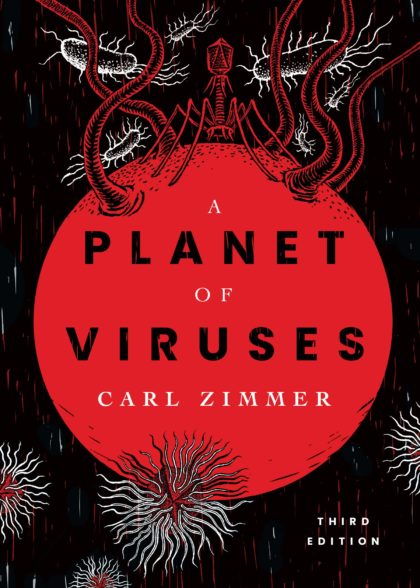
I don’t know about you, but viruses have been on my mind a lot lately. One virus in particular, SARS-CoV-2 (a.k.a. COVID-19), continues to hold my attention way more than I would like it to. However, viruses are pretty amazing, and I learned to appreciate them when I read Carl Zimmer’s book, A Planet of Viruses. Like everything I have read by Carl Zimmer, who writes a weekly science column for The New York Times, this short book is a fun read, and it doesn’t require a background in biology, or any other science, to understand and enjoy. It explores the weird and wonderful diversity of viruses on Earth and how they influence the lives of humans — even when we don’t want them too.
For context, the first edition of this book was published in 2011, well before we knew about COVID-19 but after the 2003 Sever acute respiratory syndrome (SARs) pandemic and the Swine flu (N1H1) pandemic of 2009. The updated 3rd edition includes commentary on the current virus pandemic, the lessons we could have learned from previous pandemics to help us it, and the lessons we should learn from the current pandemic in order to prevent future incidents.
A Planet of Viruses starts with a deep dive, literally, into the Cave of Crystals in Mexico. When the cave was discovered in 2000, they found, not only enormous gypsum crystals (the largest ones are 36 feet long and 3 feet thick) but also a plethora of viruses. Each drop of water from the pools in the cave contains up to 2 million viruses, which is actually a small fraction of the total number of viruses that have been discovered. The rest of this introductory chapter includes stories about virus hunters and virus discovery beginning with the very first known virus, the Tobacco Mosaic virus.
As a whole, the book explores a very small portion of the planet’s “virosphere.” Scientists estimate there are trillions of virus species, and so far, they have been able to characterize and named just a few thousand of them. Viruses are much simpler than human cells, and there is ongoing debate about whether they are actually alive. Typically, viruses are made up of a just a protein coat that surrounds a few genes worth of DNA. They survive and persist in the environment by taking over the cells of plants, animals, algae, and even bacteria. Once inside their host cell, they manipulate it into making new copies of themselves. In my opinion, viruses are as fanciful as many creatures in the average Sci-fi movie.

God, our God, will take care of the hidden things but the revealed things are our business. It’s up to us and our children to attend to all the terms in this Revelation. (Deuteronomy 29:29, The Message)
Many of the viruses in the book are familiar. Rhinoviruses, influenza, and papilloma viruses are discussed in the chapters in the section titled “Old Companions.” I found the chapter on papillomavirus, especially the section on jackalopes, bizarre yet informative. Most jackalopes — especially the ones seen in diners in Wyoming, are mythical. However, there really are rabbits that sport horns. Their horns are actually tumors caused by papillomavirus infection. Papillomavirus infections occur in all types of mammals. In humans, one form of the virus causes cervical cancer. The information on HPV and the vaccine that is currently available definitely provides food for thought about what some people consider a controversial topic.
The section titled “Everywhere, In All Things” talks about all the places viruses “live” (spoiler alert — they are found everywhere). I enjoyed the chapters on bacteriophages — curious-looking viruses that infect microbes. Some bacteriophages infect bacteria that cause human diseases, and scientists are investigating whether bacteriophages (a.k.a. phages) can be used to treat diseases like cholera or skin infections.
“The Infected Ocean” may be my favorite chapter because it talks about the astounding number and diversity of marine viruses. The current estimate is that “there are 100 billion times more viruses in the oceans than grains of sand on all the world’s beaches.” But don’t panic! Only a few infect humans. Many are phages that infect marine algae and bacteria and have a significant impact on marine ecosystems. Not only do marine phages control populations of potentially harmful bacteria, like Vibrio, the bacteria that causes cholera, but they also manage populations of algae and bacteria that produce a lot of the planet’s oxygen.

One thing I learned from this chapter and the next one, “Our Inner Parasites,” is that viruses contribute to the present-day genomes of other organisms. For example, Synechococcus bacteria produce a significant amount of oxygen via photosynthesis. When scientists looked at the Synechococcus genome, they discovered that genes that encode light-harvesting proteins likely came from viruses. Interactions between a host-cell’s DNA and virus DNA are very much like interactions described in Andy’s Quandary Den series, and sometimes the virus and the host-cell exchange genetic material. Viruses can also exchange genetic material with human host-cells, and scientists speculate that up to 8% of our DNA originated with viruses, which is definitely something to consider in conversations about human origins.
The remaining section of the book, “The Viral Future” includes tales of virus hunters tracking down the origins of Human Immunodeficiency Virus (HIV), the global spread of West Nile Virus, and recent viral pandemics. The final chapter discusses the history of vaccine discovery and the eventual elimination of smallpox.
I hope this review of A Planet of Viruses will encourage you to pick up this book and discover that viruses are everywhere, are truly bizarre, and are an integral part of Creation. I also hope you are convinced that viruses are a big picture topic and not just a current inconvenience. Ultimately, I hope I have convinced you that, given the prevalence of viruses and their impact on all aspects of human life, we need to consider viruses in our plans to take care of each other and the rest of Creation.
Dr. Julie A. Reynolds is a Research Scientist at The Ohio State University in the department of Evolution, Ecology, and Organismal Biology. She studies insect physiology and biochemistry with the goal of learning how animals adapt to extreme environments and survive changes in climate. In addition to writing for the Emerging Scholars Network, she is actively engages in discussions about science and faith as a Sinai and Synapses Fellow.

Leave a Reply